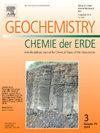Silet-Tin Felki地区的综合遥感和地球物理研究:阿尔及利亚南部Hoggar地盾泛非构造和岩浆演化的见解
IF 2.9
3区 地球科学
Q2 GEOCHEMISTRY & GEOPHYSICS
引用次数: 0
摘要
Silet-Tin Felki地区位于图阿雷格地盾内,是了解泛非造山运动和相关岩浆作用的关键地区。本研究采用综合方法,整合了遥感、航空地球物理和先前可用的地球化学数据,生成了该地区的增强岩性和构造图。包括最佳RGB波段组合和主成分分析(PCA)在内的遥感方法可以有效区分火山、花岗岩和变质岩单元。高分辨率磁能谱和伽马射线能谱进一步阐明了岩性边界和构造特征,包括显著的剪切带。研究确定了以4°50′e岩石圈剪切带为分隔的两个岩性块体:东部为latea - aouil本文章由计算机程序翻译,如有差异,请以英文原文为准。
Integrated remote sensing and geophysical studies of the Silet-Tin Felki area: Insights into the Pan-African tectonics and magmatic evolution of the Hoggar Shield, Southern Algeria
The Silet-Tin Felki area, located within the Tuareg Shield, represents a key area for understanding the Pan-African orogeny and associated magmatic processes. This study employs a comprehensive approach, integrating remote sensing, airborne geophysics, and the previously available geochemical data to produce an enhanced lithological and structural map of the area. Remote sensing methods, including optimal RGB band combinations and principal component analysis (PCA), effectively distinguish between volcanic, granitoid, and metamorphic units. High-resolution magnetic and gamma-ray spectrometry further elucidate lithological boundaries and tectonic features, including significant shear zones. The study identifies two distinct lithological blocks, separated by the 4°50′E lithospheric shear zone: the LATEA-Aouilène block to the east, featuring Neoproterozoic high-grade metamorphic rocks, and the Pharusien Belt to the west, characterized by Neoproterozoic volcanic arc and accretionary wedge complexes. The Tonian TTG batholiths in the northern Silet region display moderate radioactivity and magnetic signatures, contrasting with the highly radiogenic post-orogenic granites.
Key geodynamic features, such as mafic-ultramafic intrusions associated with a back-arc basin, were delineated, refining the regional geological model and enhancing the understanding of magmatic evolution and tectonic interactions. The integration of gamma-ray spectrometry and aeromagnetic data enabled the detailed mapping of pre-, syn-, and post-collisional granitoids, including transitional TTG suites, and revealed complex tectonic history with significant shear zones and lineaments. This updated geological framework provides critical insights for future exploration and underscores the need for further geochronological and petrological research to fully comprehend the tectono-magmatic evolution of this part of the Tuareg Shield.
求助全文
通过发布文献求助,成功后即可免费获取论文全文。
去求助
来源期刊

Chemie Der Erde-Geochemistry
地学-地球化学与地球物理
CiteScore
7.10
自引率
0.00%
发文量
40
审稿时长
3.0 months
期刊介绍:
GEOCHEMISTRY was founded as Chemie der Erde 1914 in Jena, and, hence, is one of the oldest journals for geochemistry-related topics.
GEOCHEMISTRY (formerly Chemie der Erde / Geochemistry) publishes original research papers, short communications, reviews of selected topics, and high-class invited review articles addressed at broad geosciences audience. Publications dealing with interdisciplinary questions are particularly welcome. Young scientists are especially encouraged to submit their work. Contributions will be published exclusively in English. The journal, through very personalized consultation and its worldwide distribution, offers entry into the world of international scientific communication, and promotes interdisciplinary discussion on chemical problems in a broad spectrum of geosciences.
The following topics are covered by the expertise of the members of the editorial board (see below):
-cosmochemistry, meteoritics-
igneous, metamorphic, and sedimentary petrology-
volcanology-
low & high temperature geochemistry-
experimental - theoretical - field related studies-
mineralogy - crystallography-
environmental geosciences-
archaeometry
 求助内容:
求助内容: 应助结果提醒方式:
应助结果提醒方式:


